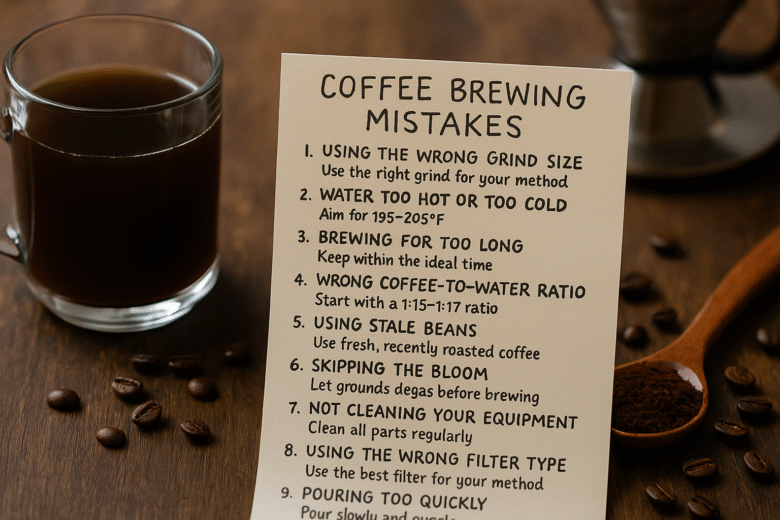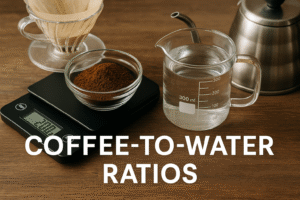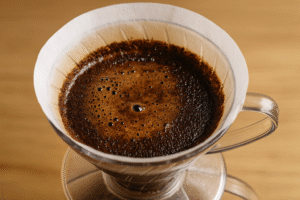You’ve followed the steps. You measured your coffee, used fresh beans, maybe even invested in a burr grinder. But your coffee still tastes off—too sour, too bitter, too bland. What went wrong?
Truth is, many home brewers unknowingly make small but impactful mistakes that ruin the flavor of their coffee. These missteps affect everything from extraction to aroma and body.
The good news is that most mistakes are easy to fix once you know what to look for. In this comprehensive guide, we’ll walk through the most common coffee brewing mistakes—and exactly how to avoid them for consistently great results.
Why Brewing Mistakes Matter
Brewing is a chemical process. Small errors in timing, temperature, ratio, or grind size lead to large differences in flavor.
Fixing one variable—like grind size—can transform your cup. Fixing all of them together? That’s when coffee becomes truly excellent.
Mistake 1: Using the Wrong Grind Size
Grind size is one of the most overlooked aspects of brewing. Each method needs a specific grind. Get it wrong, and your coffee will be poorly extracted.
Too fine = bitter and over-extracted
Too coarse = sour and under-extracted
What to do:
Use a burr grinder for even particle size. Learn the proper grind range for each method. Don’t rely on pre-ground coffee if possible.
French Press → Coarse
Pour-Over → Medium-fine
Espresso → Fine
Cold Brew → Extra coarse
AeroPress → Medium to fine
Drip Machine → Medium
Mistake 2: Using Water That’s Too Hot or Too Cold
Water temperature has a major effect on extraction. If your water is boiling, you risk burning the grounds. If it’s too cool, you under-extract and get sourness.
Ideal range: 90–96°C (195–205°F)
What to do:
Boil water, then let it sit 30 seconds before pouring. Use a thermometer or electric kettle with temperature control if you want to be precise.
Mistake 3: Brewing for the Wrong Amount of Time
Too short a brew leads to under-extraction: sour, weak coffee. Too long leads to bitterness and dry aftertaste.
What to do:
Use a timer. Learn the ideal brew time for your method:
French Press → 4:00
Pour-Over → 2:30 to 3:30
Espresso → 25–30 seconds
AeroPress → 1:30 to 2:00
Cold Brew → 12–18 hours
Drip Machine → 5–7 minutes
If your timing is off, adjust grind size to balance the flow rate.
Mistake 4: Wrong Coffee-to-Water Ratio
Eyeballing it doesn’t cut it. Too much coffee leads to overwhelming bitterness. Too little, and it’s watery.
What to do:
Start with a 1:15 to 1:17 ratio (1 gram of coffee for every 15–17 grams/ml of water).
Example: 20g coffee → 300ml water
Use a digital scale to get it right every time.
Mistake 5: Using Stale Beans
Even the best brewing method can’t rescue stale, oxidized beans. Coffee begins to lose flavor and aroma shortly after roasting—and even faster after grinding.
What to do:
Buy freshly roasted whole beans with a roast date, not a best-by date. Store them in an airtight, opaque container in a cool, dry place. Grind just before brewing.
Mistake 6: Skipping the Bloom
Especially in pour-over and French press, blooming your coffee helps release trapped carbon dioxide gas. Without this, water can’t fully saturate the grounds.
What to do:
Add a small amount of hot water (about twice the weight of the coffee), wait 30–45 seconds, then continue brewing.
Skipping this leads to uneven extraction and sour cups.
Mistake 7: Not Cleaning Your Equipment
Old coffee oils and residue build up quickly in brewers, grinders, and filters. These stale particles ruin the flavor of your fresh brew.
What to do:
Clean all brewing tools thoroughly after each use. Deep clean grinders weekly. Use vinegar or coffee descaling solutions on machines monthly.
Don’t forget reusable filters—rinse and dry them after every use.
Mistake 8: Using the Wrong Filter Type
Your filter affects body, clarity, and flavor. Using the wrong type can mute complexity or introduce grit.
What to do:
Paper filters = cleaner, brighter cup
Metal filters = more oils and body
Cloth filters = soft balance, but need maintenance
Use the right filter for your brew method, and always rinse paper filters before use.
Mistake 9: Pouring Too Quickly (or Unevenly)
In pour-over and drip methods, pouring too fast or directly in the center creates channeling—where water bypasses some grounds and over-extracts others.
What to do:
Pour slowly in spirals, starting from the center and working outward. Keep water flow even and avoid pouring on the edges of the filter.
Use a gooseneck kettle for control.
Mistake 10: Ignoring Water Quality
Coffee is 98% water. If your water tastes bad, so will your coffee—even with perfect technique.
What to do:
Use filtered water or bottled spring water. Avoid distilled or softened water, which lack the minerals needed for proper extraction.
Ideal water should have a neutral pH and light mineral content.
Bonus Mistake: Overthinking Every Brew
Yes, coffee is both an art and a science—but it’s also meant to be enjoyable.
What to do:
Start with the basics. Fix one variable at a time. Taste, adjust, repeat. The process should be fun—not stressful.
Frequently Asked Questions (FAQs)
Why is my coffee bitter?
Likely over-extracted. Try coarser grind, shorter brew time, or slightly cooler water.
Why is my coffee sour?
Probably under-extracted. Use a finer grind, longer brew time, or hotter water.
Why is my coffee weak?
Check your coffee-to-water ratio. You may be under-dosing or using too coarse a grind.
Why is my espresso pulling too fast?
Grind is likely too coarse. Adjust to a finer grind and ensure you’re tamping evenly.
Why doesn’t my coffee taste as good as the café?
Cafés control every variable: grind, water, temperature, and freshness. Aim for consistency at home and upgrade gear as needed.
Can I fix a bad cup of coffee?
Sometimes. Add a dash of salt to reduce bitterness. Or use that batch for iced coffee or cold brew.
What’s the easiest mistake to fix?
Grind size. A small change in grind has a huge impact on taste. Start there.
Final Thoughts – Brewing Better, One Fix at a Time
No one brews perfect coffee from day one. Even pros make mistakes. But the key to great coffee is understanding what went wrong—and how to fix it.
Once you take control of grind size, temperature, ratio, and timing, your coffee improves dramatically. You don’t need to be a barista. You just need to be curious and consistent.
Make small changes. Take notes. Trust your taste buds. And enjoy the journey—because great coffee is always a process, never just a recipe.

Marcio Luzardo is a coffee enthusiast and the voice behind Tudo Viraliza. With a passion for turning curiosity into practical knowledge, he shares easy-to-follow tips, guides, and insights to help readers enjoy better coffee every day. When he’s not writing, Marcio is exploring new brewing methods or diving into the rich stories that connect coffee to culture, lifestyle, and wellness.



